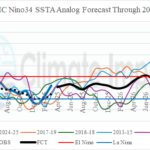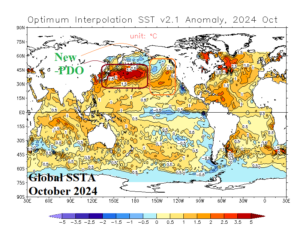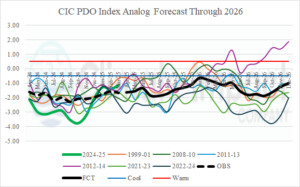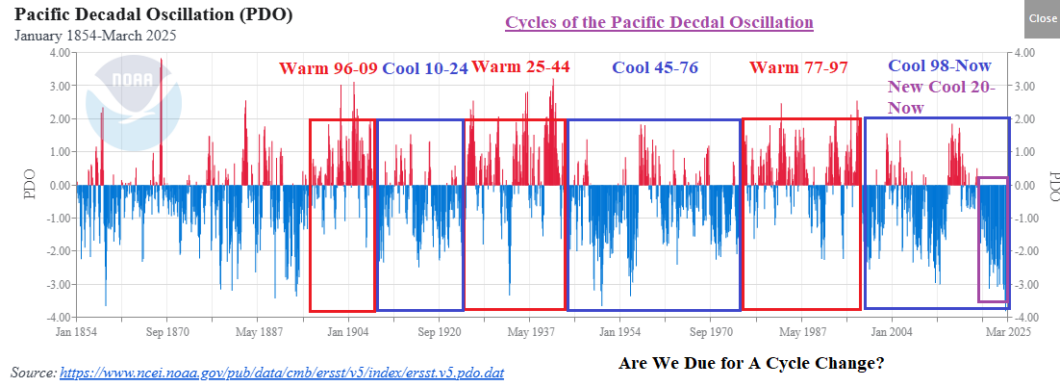
Most Likely: Neutral ENSO 2025; El Nino 2026
04/08/2025, 5:43 am EDT
April 2025 Climate Impact Company Marine Heat Waves Outlook
04/16/2025, 4:41 pm EDTExecutive summary: The cool cycle of the Pacific decadal oscillation has strengthened during recent years and will reach 30 years in duration if continued through 2026 as forecast by the Climate Impact Company constructed analog prediction. The 30-year duration matches the previous longest cool cycle observed during the middle 1940’s to middle 1970’s. Are we due for a long-term cycle change of the PDO? The question is made complicated by the warming of the mid-latitude oceans accelerating during recent years.

Fig. 1: The Pacific decadal oscillation index and cool/warm cycles.
Discussion: The Pacific decadal oscillation (PDO) is a leading mode of climate variability well-correlated with western North America precipitation patterns and a general link to phase of El Nino southern oscillation (ENSO). When the cool phase (-PDO) is present, the Northwest U.S. is generally wetter than normal while a drier than normal climate is common in this region during the warm phase (+PDO). Generally (not always), -PDO is accompanied by La Nina while +PDO is present during El Nino. The PDO/ENSO combination represents a powerful influence on North America climate. The PDO cycle changes every 15-32 years, based on observations since the late 1800’s (Fig. 1). Currently, the -PDO cycle continues and is approaching 30 years in length (almost) matching the middle 1940’s to middle 1970’s -PDO cycle which is the longest on record. Are we about to witness a PDO cycle change?
Modern-day -PDO is much different from our historical understanding of the North Pacific SSTA regime that causes PDO phase. Normally -PDO is produced by cooler than normal SSTA in the Northeast Pacific while the northwest Pacific is much warmer than normal (Fig. 2). However, “new” -PDO is much different. The northeast Pacific is warmer than normal, similar with a +PDO regime. However, waters near the Dateline to East Coastal Asia are record warm and the anomaly comparison renders -PDO (Fig. 3). In fact, the “new” -PDO of this decade may be the strongest on record fueled by the record warmth of the northwest Pacific basin. The warmer Northeast Pacific waters during the strong -PDO of this decade have caused the Northwest U.S. to turn much drier compared to the wetter “old” -PDO.


Fig. 2-3: An example of the North Pacific SSTA regime during “old” versus “new” cool phase of the Pacific decadal oscillation.
The Climate Impact Company PDO constructed analog forecast through 2026 indicates the cool phase continues in 2025, weakens during early 2026, and regains strength later next year (Fig. 4). The continuing -PDO is fueled primarily by very warm waters near and west of the Dateline while the ocean surface in the northeast Pacific is less anomalous warm. Consequently, the prevailing climate across western North America is closer to the historic +PDO character (warm and dry bias) versus wet and cool conditions associated with the “old” -PDO. The analog forecast does not suggest a cycle change through 2026 which brings the current cool cycle to 30 years. A cycle change to the warm phase is likely reliant on the West Pacific cooling off.

Fig. 4: The Climate Impact Company constructed analog forecast of PDO index through 2026.
Summary: The character of -PDO has changed. The influence of “new” PDO has similarities to +PDO climatology in North America whereas the Northwest U.S. is drier and warmer than typical -PDO climate. The reason is the relative (much) warmer waters near and west of the Dateline. The current -PDO cycle should be nearing an ending based on climatology. However, a cycle change to the positive phase is likely dependent on cooling of northwest and central North Pacific. The warming oceans, accelerating during recent years, has caused the PDO character change.

